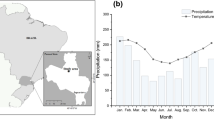Abstract
This study mainly estimated the carbon stored in Pinus koraiensis based on radial stem growth. Radial growth ring density was obtained with the X-ray microdensitometer from radial strips. Growth ring width, latewood percentage and growth rate in each growth ring were measured from remaining disks with a micrometer fitted in stereoscope. The amount of carbon fixed in wood was obtained based on the incremental growth of entire tree, as well as wood density in a particular growth ring. Results based on radial variation in the growth ring density indicated that the plantation P. koraiensis trees began to produce mature wood at 17 years of age. After reaching maturity, growth ring density decreased. By around 7 years of age, growth ring width began decreasing, whereas latewood percentage steadily increased until maturity. The overall growth rate decreased rapidly, from pith to approximately the ninth growth ring. The amount of carbon fixed in wood was positively correlated with growth ring density and latewood percentage and negatively correlated with growth ring width and growth rate. These correlations were significant at 1% confidence level. Thus, carbon storage is accurately predicted from tree growth characteristics.








Similar content being viewed by others
References
Ayres, M. P., & Lombardero, M. J. (2000). Assessing the consequences of global change for forest disturbance from herbivores and pathogens. Science of the Total Environment, 262(3), 263–286.
Rattan, L. (2008). Carbon sequestration. Philosophical Transactions of the Royal Society, 363(1098), 815–830.
Shen, J., Song, Z. Q., Qian, X. R., Liu, W. X., & Yang, F. (2010). Fillers and the carbon footprint of papermaking. BioResources, 5(4), 2026–2028.
Perez-Garcia, J., Lippke, B., Comnick, J., & Manriquez, C. (2005). An assessment of carbon pools, storage, and wood products market substitution using life-cycle analysis results. Wood and Fiber Science, 37(1), 140–148.
Liu, G. L., & Han, S. J. (2009). Long-term forest management and timely transfer of carbon into wood products help reduce atmospheric carbon. Ecological Modeling, 220(13), 1719–1723.
Lehmann, S. (2013). Low carbon construction systems using prefabricated engineered solid wood panels for urban infill to significantly reduce greenhouse gas emissions. Sustainable Cities and Society, 6, 57–67.
Li, J. (2007). Wood carbon storage and environmental effect. Furniture, 3(157), 32–36.
Chen, H. L., Cao, F. J., Huang, X., & Chen, H. Y. (2008). Trees breeding technology research to improve wood carbon storage. Hubei Forestry Science and Technology, 6(154), 42–46.
Okochi, Takayuki. (2016). A nondestructive dendrochronological study on japanese wooden shinto art sculptures using micro-focus x-ray computed tomography (CT). Dendrochronologia, 38, 1–10.
Li, J. (2010). Response characteristics and low carbon processing analysis of wood for environmental protection. Journal of Northeast Forestry University, 38(6), 111–114.
Han, L. N., Yu, S. Y., Xu, M., et al. (2011). The recycling of waste wood and carbon storage. Forestry Science and Technology, 36(4), 40–42.
Guan, X., Guo, M. H. & Li, J. (2010). Study the effect of growing environment on carbon sequestration of Populus ussuriensis based on wood microscopic image processing. In 3rd international conference on environmental and computer science (Vol. 1, pp. 128–131).
Guo, M. H., & Qin, L. (2015). Radial Variation Between the Wood Carbon Storage and Physical Characteristics of the Man-planted Pinus koraiensis. Forest Science, 51(1), 97–102.
Guo, M. H., Guan, X., & Li, J. (2012). Study the effect of site conditions on carbon storage and physical characteristics of Populus Ussuriensis. Advanced Science Letters, 5(2), 644–647.
Acknowledgements
The authors are grateful for the support from the Scientific Research Starting Foundation of Southwest Forestry University (Grant No. 111434), and Chinese Central Government (the 12th Five-Year Science and Technology Support Program, Grant No. 2011BAD08B0304).
Author information
Authors and Affiliations
Corresponding author
Rights and permissions
About this article
Cite this article
Qin, L., Qiu, J. & Guo, M. Estimating Carbon Storage Based on the Radial Stem Growth of Pinus koraiensis. Wireless Pers Commun 102, 3101–3110 (2018). https://doi.org/10.1007/s11277-018-5330-4
Published:
Issue Date:
DOI: https://doi.org/10.1007/s11277-018-5330-4




